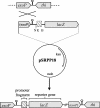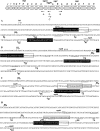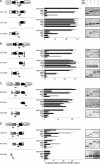Fine-tuning of galactoglucan biosynthesis in Sinorhizobium meliloti by differential WggR (ExpG)-, PhoB-, and MucR-dependent regulation of two promoters
- PMID: 18344362
- PMCID: PMC2394980
- DOI: 10.1128/JB.00062-08
Fine-tuning of galactoglucan biosynthesis in Sinorhizobium meliloti by differential WggR (ExpG)-, PhoB-, and MucR-dependent regulation of two promoters
Abstract
Depending on the phosphate concentration encountered in the environment Sinorhizobium meliloti 2011 synthesizes two different exopolysaccharides (EPS). Galactoglucan (EPS II) is produced under phosphate starvation but also in the presence of extra copies of the transcriptional regulator WggR (ExpG) or as a consequence of a mutation in mucR. The galactoglucan biosynthesis gene cluster contains the operons wga (expA), wge (expE), wgd (expD), and wggR (expG). Two promoters, differentially controlled by WggR, PhoB, and MucR, were identified upstream of each of these operons. The proximal promoters of the wga, wge, and wgd transcription units were constitutively active when separated from the upstream regulatory sequences. Promoter activity studies and the positions of predicted PhoB and WggR binding sites suggested that the proximal promoters are cooperatively induced by PhoB and WggR. MucR was shown to strongly inhibit the distal promoters and bound to the DNA in the vicinity of the distal transcription start sites. An additional inhibitory effect on the distal promoter of the structural galactoglucan biosynthesis genes was identified as a new feature of WggR in a mucR mutant. A regulatory model of the fine-tuning of galactoglucan production is proposed.
Figures





References
-
- Aman, P., M. McNeil, L. E. Franzen, A. G. Darvill, and P. Albersheim. 1981. Structural elucidation using HPLC-MS and GLC-MS of the acidic polysaccharide secreted by Rhizobium meliloti strain 1021. Carbohydr. Res. 95263-282.
-
- Astete, S. G., and J. A. Leigh. 1996. mucS, a gene involved in activation of galactoglucan (EPS II) synthesis gene expression in Rhizobium meliloti. Mol. Plant-Microbe Interact. 9395-400. - PubMed
-
- Barnard, A., A. Wolfe, and S. Busby. 2004. Regulation at complex bacterial promoters: how bacteria use different promoter organizations to produce different regulatory outcomes. Curr. Opin. Microbiol. 7102-108. - PubMed
-
- Bartels, F. W., B. Baumgarth, D. Anselmetti, R. Ros, and A. Becker. 2003. Specific binding of the regulatory protein ExpG to promoter regions of the galactoglucan biosynthesis gene cluster of Sinorhizobium meliloti: a combined molecular biology and force spectroscopy investigation. J. Struct. Biol. 143145-152. - PubMed
-
- Baumgarth, B., F. W. Bartels, D. Anselmetti, A. Becker, and R. Ros. 2005. Detailed studies of the binding mechanism of the Sinorhizobium meliloti transcriptional activator ExpG to DNA. Microbiology 151259-268. - PubMed
Publication types
MeSH terms
Substances
LinkOut - more resources
Full Text Sources
Other Literature Sources
Molecular Biology Databases

